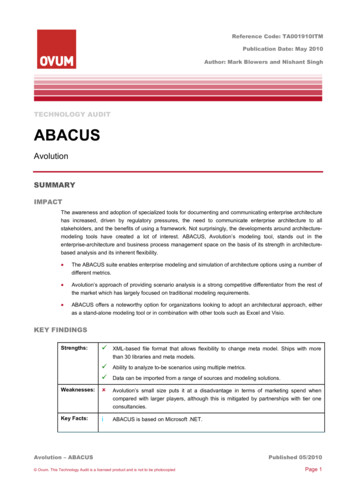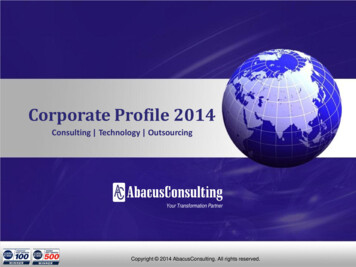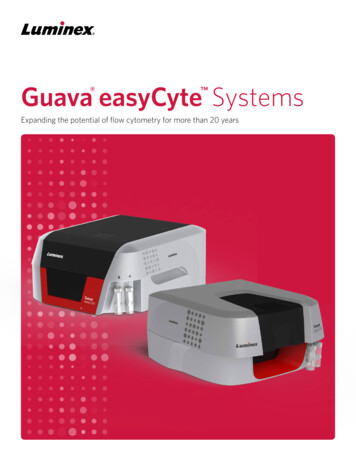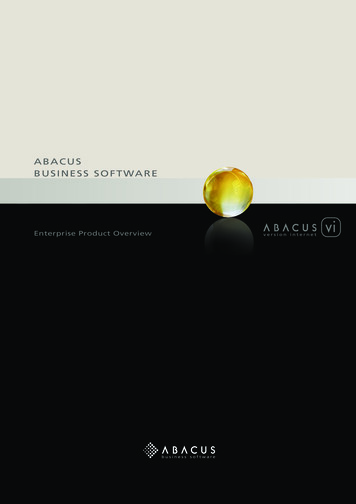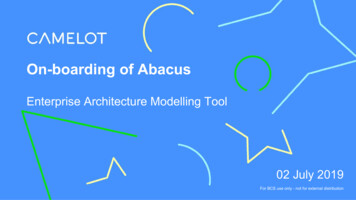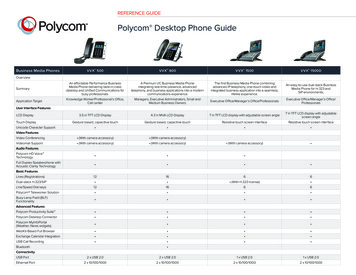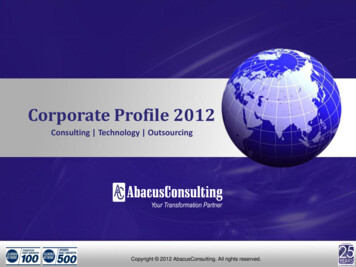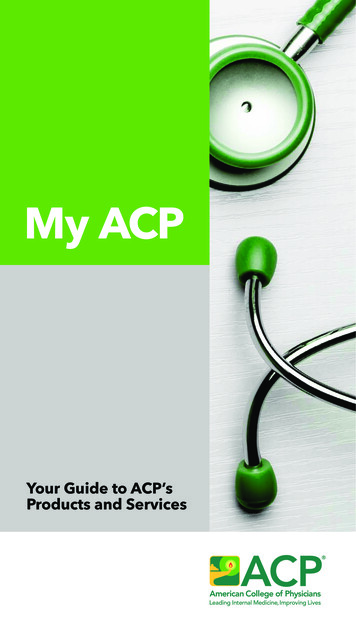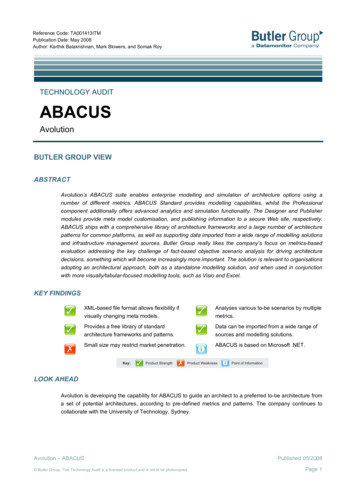
Transcription
Reference Code: TA001413ITMPublication Date: May 2008Author: Karthik Balakrishnan, Mark Blowers, and Somak RoyTECHNOLOGY AUDITABACUSAvolutionBUTLER GROUP VIEWABSTRACTAvolution’s ABACUS suite enables enterprise modelling and simulation of architecture options using anumber of different metrics. ABACUS Standard provides modelling capabilities, whilst the Professionalcomponent additionally offers advanced analytics and simulation functionality. The Designer and Publishermodules provide meta model customisation, and publishing information to a secure Web site, respectively.ABACUS ships with a comprehensive library of architecture frameworks and a large number of architecturepatterns for common platforms, as well as supporting data imported from a wide range of modelling solutionsand infrastructure management sources. Butler Group really likes the company’s focus on metrics-basedevaluation addressing the key challenge of fact-based objective scenario analysis for driving architecturedecisions, something which will become increasingly more important. The solution is relevant to organisationsadopting an architectural approach, both as a standalone modelling solution, and when used in conjunctionwith more visually/tabular-focused modelling tools, such as Visio and Excel.KEY FINDINGSXML-based file format allows flexibility ifvisually changing meta models.Analyses various to-be scenarios by multiplemetrics.Provides a free library of standardarchitecture frameworks and patterns.Data can be imported from a wide range ofsources and modelling solutions.Small size may restrict market penetration.ABACUS is based on Microsoft .NET.LOOK AHEADAvolution is developing the capability for ABACUS to guide an architect to a preferred to-be architecture froma set of potential architectures, according to pre-defined metrics and patterns. The company continues tocollaborate with the University of Technology, Sydney.Avolution – ABACUS Butler Group. This Technology Audit is a licensed product and is not to be photocopiedPublished 05/2008Page 1
TECHNOLOGY AUDITFUNCTIONALITYOver the last several years the awareness and adoption of specialised tools for documenting andcommunicating Enterprise Architecture in a centralised way has increased, driven by multiple overlappingregulatory pressures, considerations of standards-based development, and the benefits of best-practiceframeworks. Whilst organisations have benefited from establishing reference architectures, and cascadingrequirements and constraints to downstream activities, Enterprise Architecture as a discipline still lacks thedata and performance analytics driven approach that is slowly becoming pervasive in IT. Without a fact-basedassessment of each architecture option, Enterprise Architecture is prone to be guided by opinion, which canprove relatively expensive, be open to manipulation, and sometimes inefficient.Product AnalysisAvolution supplies the ABACUS Standard and Professional modules with the latter providing the full set ofarchitecture modelling and scenario analysis capability and the former offering mostly architecture modellingfunctionality. The solution enables enterprise modelling based on the Component, Connection, andConstraints framework with features for assigning properties for components and connections, which areaccessible through a tabular view alongside the graphical models (see Figure 1). An ABACUS file comprisesof meta models and multiple architectures, along with views for each meta model. The solution provides alarge set of libraries comprising standard frameworks, such as Zachman and The Open Group ArchitectureFramework (TOGAF), along with common architecture patterns.ABACUS Professional is focused primarily on simulation. A typical usage scenario would involve as an initialstep creating architecture models either by modifying ABACUS libraries, importing models from tools, such asVisio and Excel, or from scratch, and creating multiple architecture scenarios by editing properties (the datacan be imported from a host of databases, spreadsheets, CMDBs, and service desk solutions) and alsocomponents and connectors. The user would then run simulation models that generate metrics onperformance, reliability, Total Cost of Ownership (TCO), and many others which are displayed through a veryimpressive set of charts and graphs. It is the focus on simulation capability that makes Avolution a pioneer inthe Enterprise Architecture modelling space and relevant to a wide range of companies in the enterprise,software, and System Integrator (SI) sectors.The simulation capability includes Star Plots which rate architectural scenarios against multiple parameters,which could include factors such as ‘openness’ and ‘security’, in addition to performance, reliability, and TCO.Additionally, the Star Plot chart allows easy visual determination of the evolution of architectures and allowsusers a high degree of flexibility in prioritising decision parameters. Butler Group is impressed with the rangeof infrastructure data sources supported and the data import/export mechanism. Avolution, whilst offeringimport from other modelling tools, is focused very much on easy import from Visio and Excel. Given that theMicrosoft Office tool-suite remains the de facto modelling tool for the majority of organisations, Butler Groupbelieves this to be the right approach. Overall, ABACUS is a solution well aligned with the requirements notonly of Enterprise Architecture, but potentially for a variety of infrastructure initiatives and processoptimisation projects.Avolution – ABACUS Butler Group. This Technology Audit is a licensed product and is not to be photocopiedPublished 05/2008Page 2
TECHNOLOGY AUDITFigure 1:ABACUS OverviewSource: AvolutionDATAMONITORProduct OperationThe ABACUS suite consists of four Microsoft .NET-based products namely ABACUS Standard, ABACUSDesigner, ABACUS Professional, and ABACUS Publisher. The ABACUS Standard edition is the entry-levelsolution that offers comprehensive architecture modelling functionality, some analytical capability, andcommon repository, along with extensive data import and export capabilities. ABACUS Professional providesadditional evaluation functionality, such as comparison of architecture options by performance, TCO,reliability, and other metrics. The ABACUS Designer ships as an add on to the Professional and Standardeditions and enables the creation of meta models based on pre-defined ABACUS libraries, or entirely newframeworks. The ABACUS Publisher which is also shipped as an add on to both editions allows publishing of2D and 3D models, along with metrics, to a secure Web site, enabling a completely customisableenvironment where, if required, only specific portions of models can be made available.At the heart of ABACUS is a XML-based file format (tree-based hierarchical file storage structure) which actsas an objects database. A new component or connection, the building blocks of ABACUS architecturemodels, is saved as another object in the objects database. This infrastructural difference is significantbecause creation of new architecture meta models or enhancements to existing meta models can beimplemented using simple ‘right-clicks’ in the standard User Interface, as opposed to making changes to theinternal database that many modelling tools need to do. The changing of meta models solely by updating theinternal database typically leads to long implementation times for customising meta model frameworks (whichagain remain rigid) and offers limited scope for expansion or enhancements.Avolution – ABACUS Butler Group. This Technology Audit is a licensed product and is not to be photocopiedPublished 05/2008Page 3
TECHNOLOGY AUDITThe ABACUS approach to defining meta models uses three key units, Component, Connection, andConstraints, a structure that conforms to the IEEE1471 standard. It would be pertinent to mention in thiscontext that Avolution’s founders were contributors to the IEEE standard. ABACUS ships with various librariesof such components, connectors, and constraints. Examples of Component, Connection, and Constraintswould be servers or applications, physical or logical connections, and the component logical hierarchy orparent child relationships respectively. ABACUS ships with over ten such libraries or meta models, i.e. sets ofComponent, Connection, and Constraints, including TOGAF, Zachman, Capgemini IAF, and DoDAF/MoDAF.The ABACUS list of libraries includes over 50 common architectural patterns. The flexibility of the Avolutionapproach manifests in a much larger number of standard architectural frameworks available compared toother modelling solution providers. The solution permits users to create new libraries, as well as mergingexisting libraries, to create an organisation specific framework in a matter of minutes.Importantly, ABACUS offers significant import/export capability with common modelling solutions (and defacto sources of architecture and process related information) and with common sources of infrastructurerelated data. Data can be imported/exported from/to Microsoft Visio, Excel, and Powerpoint, as well as CoreliGrafx, Casewise Corporate Modeler, Rational System Architect, and Proforma Provision. ABACUS integrateswith relational database such as Microsoft Access and SQL Server, along with CMDBs such as HPOpenview, IBM Tivoli, CA UniCenter, Centennial Discovery, BMC Patrol, and Solarwinds Orion, and alsoservice desk solutions such as those from HP, CA, and Sunrise. Integration with third-party solutions isaccomplished through a variety of means including scripting for data access from external repositories,XML/XMI, and using the ABACUS DB/SQL importers to extract data from other tool databases.All components that are present in the models can have properties such as behaviour and cost attached tothem and can be viewed in the context of the architectural models. The properties provide the base data forsimulation capabilities, which are aimed at helping users make fact-based decisions on architecture tradeoffs, understand performance, reliability, and cost considerations of comparable architectures, and analysethe impact of change.ABACUS Professional allows users to create many architectures in the same repository thus allowing theusers to view as-is and also the to-be architecture(s) in the same model. The solution allows users to modifyproperties of the components as well as visually alter the components and connections to simulate theperformance and cost impact of the changes. Simulations include performance evaluation which utilises aDiscrete EVent Simulator (DEVS) that assesses the flow of messages through the architecture across variouscomponents.Performance simulation is based on Layered Queuing Network Models and Activity Cycle Diagrams. Keysimulation capability includes Total Cost of Ownership (TCO) comparison, which works by assigning costs tocomponents in an architecture, and reliability evaluation, which utilises Monte Carlo simulations with MeanTime to Repair and Mean Time between Failures of components. Finally, ABACUS Professional provides theCapability Space Diagrams and Star Plots (see Figure 2) that map and visually compare any number ofarchitecture models across multiple parameters, aimed at providing representation of evolution in a forcevector like way.Avolution – ABACUS Butler Group. This Technology Audit is a licensed product and is not to be photocopiedPublished 05/2008Page 4
TECHNOLOGY AUDITFigure 2:Star Plot AnalysisSource: AvolutionDATAMONITORWhilst the traditional scope of enterprise modelling, namely documentation, communication, collaboration,and to a limited extent monitoring is not the main focus area for Avolution, the ABACUS solution does providea set of key features such as model querying, model check in/check out, and policy-based notification in theevent of repository rule violation.ABACUS also allows 3D modelling which is a very unique feature in the enterprise modelling industry and thiscapability allows users to view models at a level of detail much higher to that obtained in a 2D view. Currently2D views can be exported to SVG and HTML, whilst 3D views are exported to VRML or HTML. Reports areexported to HTML, PDF, Crystal Reports, Microsoft Word and Microsoft Excel, with graphs output to BMP.The entire model can be exported/published to XML, Microsoft Access, or HTML. Overall, Butler Group isvery impressed with the visual richness of the 2D and 3D models, including the component and connectoriconography and the intuitiveness of the charts and graphs.Product EmphasisThe ABACUS solution is focused on three key aspects. Firstly, the flexibility of meta model creation, includingeasy import from existing models, especially those built on Visio and Excel; secondly, providing simulation ofarchitecture options, enabled partly by the capability to quickly create multiple scenarios through architectureand attribute property modification; and finally integrating with a wide range of infrastructure data sources.Avolution also caters for the graphical ease of modelling and Butler Group is impressed with the richiconography that can be used to build components and the virtually unique provision of 3D modellingcapability.Avolution – ABACUS Butler Group. This Technology Audit is a licensed product and is not to be photocopiedPublished 05/2008Page 5
TECHNOLOGY AUDITDEPLOYMENTAccording to Avolution, deployment effort is minimal for basic implementation and organisations can easilydownload and install ABACUS. Implementation takes around one hour and there are no significant businessprocedures that need to be changed, since ABACUS easily integrates with many standard business methods,processes, and frameworks.The company has partnerships with several SIs for value-added services, but usually not much expertise isrequired for installation. Unlike a lot of focused modelling solutions, ABACUS is aimed on enabling theindividual architect to quickly define architecture models and perform trade off simulations, and thereforeinstallation does not involve the usual model building phase. ABACUS can be deployed using a modularapproach and organisations can implement ABACUS Standard as the base product and deploy the otherthree products ABACUS Professional, ABACUS Designer, and ABACUS Publisher, as add-ons.Avolution’s typical deployment involves between 3 and 5 seats, as a separate ‘drawing tool’ is typically usedfor broader Business Process Management (BPM) requirements. ABACUS clients are a Windows .NETapplication, which run on Microsoft Windows 2000, Windows XP SP2, or later platforms and the ABACUSserver requires the Subversion platform which is freely available for Red Hat 8.0 and 9, SPARC/Solaris 2.5 –10, Mac OS X, Windows NT, 2000, XP and 2003, HP UX, AIC and IBM i5/OS. ABACUS Standard requiresMicrosoft Office 2003, or higher version for Visio and Excel import/export features. The ABACUS Publisheralso runs on the above mentioned platforms, as well as accommodating Linux, and Mac OS. The Publisherclient requires Firefox 1.5, or higher, or Microsoft Internet Explorer 6, or higher, and the SVG and VRMLViewers, which are freely available.The company offers half and full-day training courses either on-site or at the nearest Avolution office. Limited‘self-learning’ tools are also available. Avolution has created an online community that contains a wealth oftutorials, case studies, libraries, and user forums for assistance. The product support provided is based onthe type of contract selected by organisations, which can be General, Gold, or Platinum maintenance. Whilstthe General category provides only minor upgrades of ABACUS (unlimited) with a 24x7 hour e-mail support,the Gold and Platinum cover offers unlimited major and minor upgrades, along with 24x7 hour e-mail support,a 9-hour per-day phone support and extra hours of on-site support at a discounted rate, depending on thelicense scheme purchased by the customer.PRODUCT STRATEGYAvolution focuses on large enterprises with more than 250 people that have complex technologyinfrastructures, with a combination of legacy systems and a strong pipeline of new developments. Avolution’starget markets include architecture practitioners in complex environments, SIs, consultancies,software/system development houses, and infrastructure providers.As would be expected from a tool of this nature, Return On Investment (ROI) cannot be measured exactly anddepends on benefits, such as increased re-use of existing solutions/resources, reduced time for producttransformations, and improved architecture-related decision making. Avolution claims that ABACUS practitionershave reported a reduction in process analysis time, an improvement of between 20% and 30% in the successrate of proposals, and have avoided additional costs by not making wrong decisions. The common meta-modelapproach can provide up to 20% in overall efficiency improvement across the organisation.Avolution – ABACUS Butler Group. This Technology Audit is a licensed product and is not to be photocopiedPublished 05/2008Page 6
TECHNOLOGY AUDITAvolution sells its products through a direct sales force, strategic partnerships with network integrationcompanies that influence corporate IT decision making, and channel partnerships with organisations thatadvise corporations on their IT and business strategies. Avolution has business partnerships with BT GlobalServices, Capita, Arismore, Resultex, and EA Werks, as well as technology partnerships with Microsoft, IBM,The Open Group, and CapGemini IAF.Butler Group believes that the Avolution metrics-based approach will become increasingly more pertinent andthere is a strong possibility that a large vendor will enter this space in the next three years. Therefore,Avolution’s continued relevance is contingent upon expanding direct sales and channel partnerships,something which may prove difficult due to the small size of the company. In addition, the company needs tobuild closer relationships with other ISVs, in areas such as Business Intelligence (BI), BPM, PortfolioManagement, software development, and systems management.ABACUS can be supplied as an integrated suite or as individual component modules. The licenses need tobe purchased upfront and there is an optional annual 20% maintenance fee for General maintenance. Theaverage project value over the first year is UK 120,000 with services comprising 40% of the cost, whilstthrough the next three years the average cost is UK 24,000 per annum (primarily maintenance). Avolutiontypically targets a quarterly minor and an annual major release strategy for its products, however, the betareleases are available 1-2 months prior to this for refinement purposes.COMPANY PROFILEAvolution is a private company, founded in 2001 as a spin-off from the University of Technology, Sydney. Thecompany is headquartered in Australia and was launched with the goal of commercialising over 15 years ofresearch that is now part of ABACUS. The company’s European operation is headquartered in Oxford, whilstthe recently opened American business is headquartered in the Washington DC Metropolitan area. The firstthree years of the company’s existence were spent purely developing and marketing the product, with theinitial release of ABACUS being in late 2004.Avolution has 20 employees with a majority based in Australia. Expected employee growth is 30% largely dueto expansion in the US. About 40% of Avolution’s employees are engaged in the Research and Developmentfunction. ABACUS has deployed the solution in 24 countries and it is being used by over 100 differentorganisations. Some of the referenceable clients of Avolution include Alcatel-Lucent Australia, ANZ BankAustralia, AXA France and UK, Birmingham City Council UK, British Telecom, Business Link UK, Capita UK,CIT Bank USA, WMATA USA, Department of Defence Australia, Fujitsu, Insurance Australia Gr
Avolution’s ABACUS suite enables enterprise modelling and simulation of architecture options using a number of different metrics. ABACUS Standard provides modelling capabilities, whilst the Professional component additionally offe
